coolant level DODGE CHALLENGER 2017 3.G Owners Manual
[x] Cancel search | Manufacturer: DODGE, Model Year: 2017, Model line: CHALLENGER, Model: DODGE CHALLENGER 2017 3.GPages: 506, PDF Size: 4.44 MB
Page 175 of 506
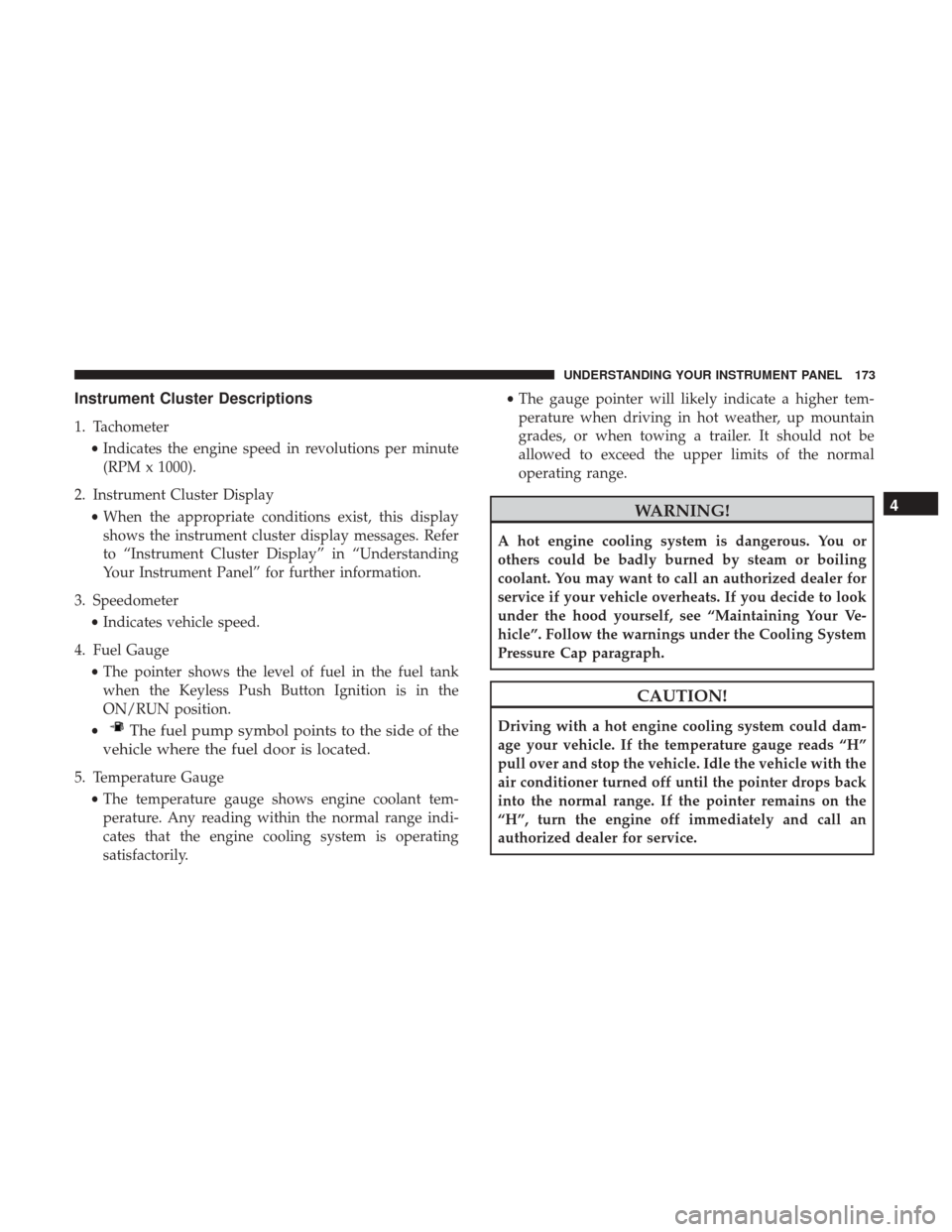
Instrument Cluster Descriptions
1. Tachometer•Indicates the engine speed in revolutions per minute
(RPM x 1000).
2. Instrument Cluster Display •When the appropriate conditions exist, this display
shows the instrument cluster display messages. Refer
to “Instrument Cluster Display” in “Understanding
Your Instrument Panel” for further information.
3. Speedometer •Indicates vehicle speed.
4. Fuel Gauge •The pointer shows the level of fuel in the fuel tank
when the Keyless Push Button Ignition is in the
ON/RUN position.
•
The fuel pump symbol points to the side of the
vehicle where the fuel door is located.
5. Temperature Gauge
•The temperature gauge shows engine coolant tem-
perature. Any reading within the normal range indi-
cates that the engine cooling system is operating
satisfactorily. •
The gauge pointer will likely indicate a higher tem-
perature when driving in hot weather, up mountain
grades, or when towing a trailer. It should not be
allowed to exceed the upper limits of the normal
operating range.
WARNING!
A hot engine cooling system is dangerous. You or
others could be badly burned by steam or boiling
coolant. You may want to call an authorized dealer for
service if your vehicle overheats. If you decide to look
under the hood yourself, see “Maintaining Your Ve-
hicle”. Follow the warnings under the Cooling System
Pressure Cap paragraph.
CAUTION!
Driving with a hot engine cooling system could dam-
age your vehicle. If the temperature gauge reads “H”
pull over and stop the vehicle. Idle the vehicle with the
air conditioner turned off until the pointer drops back
into the normal range. If the pointer remains on the
“H”, turn the engine off immediately and call an
authorized dealer for service.
4
UNDERSTANDING YOUR INSTRUMENT PANEL 173
Page 434 of 506
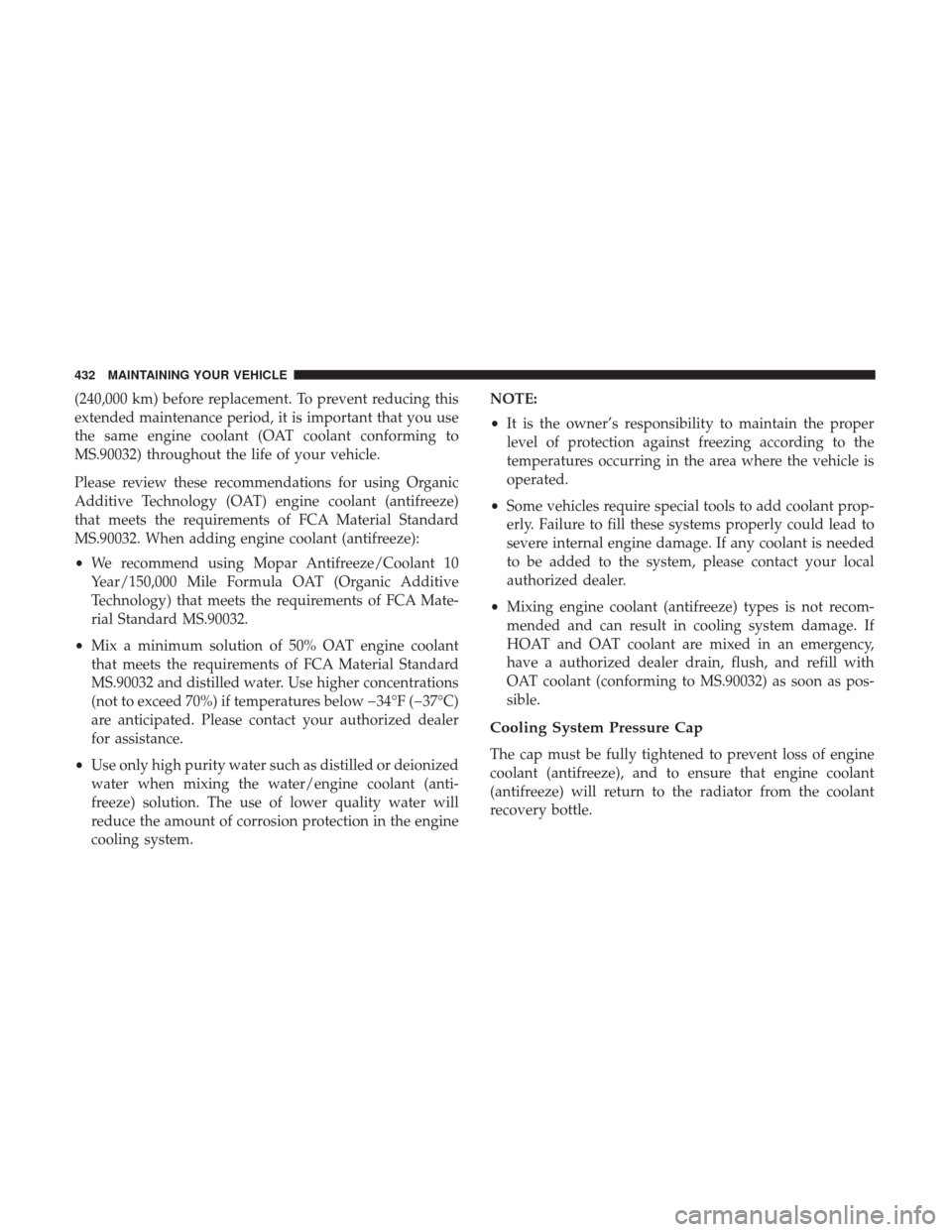
(240,000 km) before replacement. To prevent reducing this
extended maintenance period, it is important that you use
the same engine coolant (OAT coolant conforming to
MS.90032) throughout the life of your vehicle.
Please review these recommendations for using Organic
Additive Technology (OAT) engine coolant (antifreeze)
that meets the requirements of FCA Material Standard
MS.90032. When adding engine coolant (antifreeze):
•We recommend using Mopar Antifreeze/Coolant 10
Year/150,000 Mile Formula OAT (Organic Additive
Technology) that meets the requirements of FCA Mate-
rial Standard MS.90032.
• Mix a minimum solution of 50% OAT engine coolant
that meets the requirements of FCA Material Standard
MS.90032 and distilled water. Use higher concentrations
(not to exceed 70%) if temperatures below �34°F (�37°C)
are anticipated. Please contact your authorized dealer
for assistance.
• Use only high purity water such as distilled or deionized
water when mixing the water/engine coolant (anti-
freeze) solution. The use of lower quality water will
reduce the amount of corrosion protection in the engine
cooling system. NOTE:
•
It is the owner’s responsibility to maintain the proper
level of protection against freezing according to the
temperatures occurring in the area where the vehicle is
operated.
• Some vehicles require special tools to add coolant prop-
erly. Failure to fill these systems properly could lead to
severe internal engine damage. If any coolant is needed
to be added to the system, please contact your local
authorized dealer.
• Mixing engine coolant (antifreeze) types is not recom-
mended and can result in cooling system damage. If
HOAT and OAT coolant are mixed in an emergency,
have a authorized dealer drain, flush, and refill with
OAT coolant (conforming to MS.90032) as soon as pos-
sible.
Cooling System Pressure Cap
The cap must be fully tightened to prevent loss of engine
coolant (antifreeze), and to ensure that engine coolant
(antifreeze) will return to the radiator from the coolant
recovery bottle.
432 MAINTAINING YOUR VEHICLE
Page 435 of 506
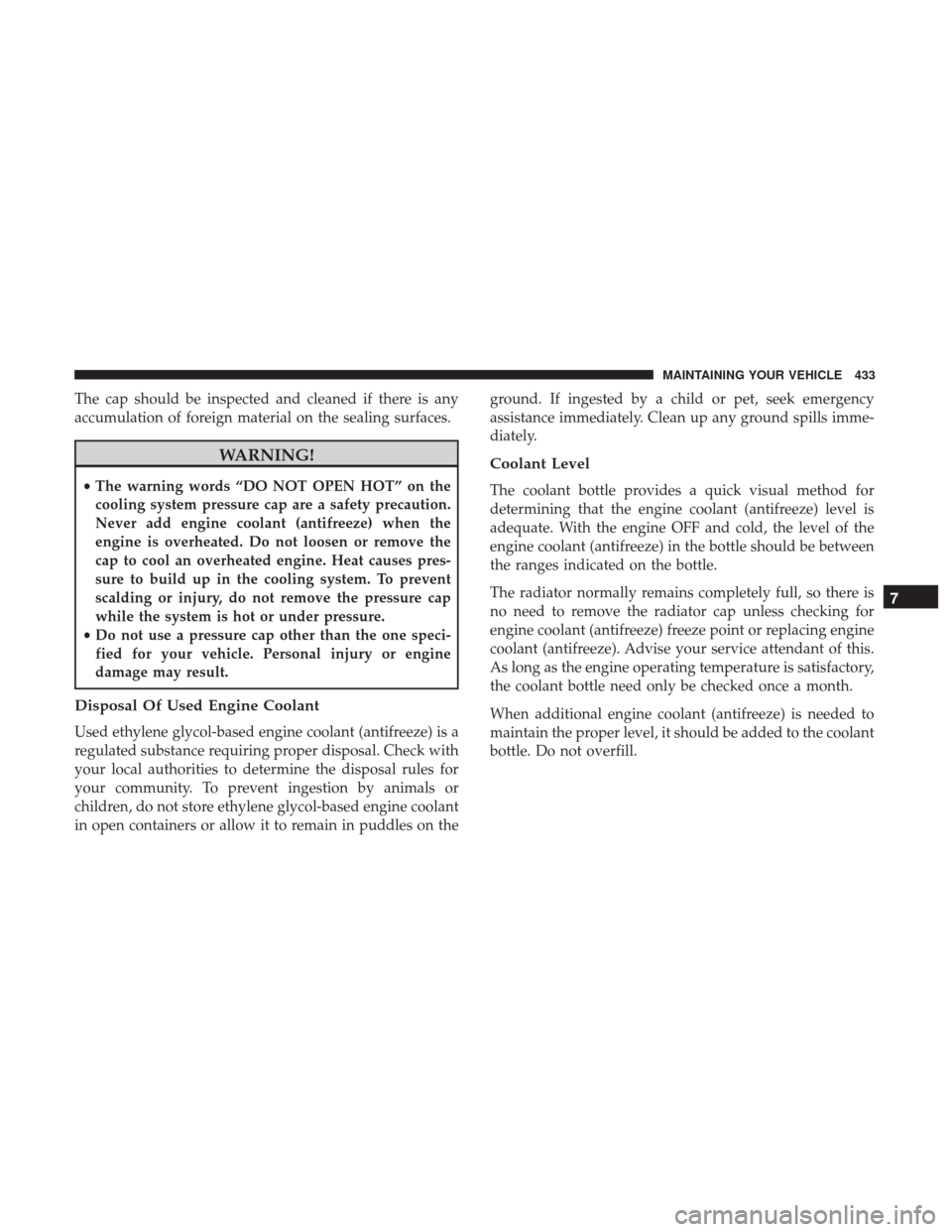
The cap should be inspected and cleaned if there is any
accumulation of foreign material on the sealing surfaces.
WARNING!
•The warning words “DO NOT OPEN HOT” on the
cooling system pressure cap are a safety precaution.
Never add engine coolant (antifreeze) when the
engine is overheated. Do not loosen or remove the
cap to cool an overheated engine. Heat causes pres-
sure to build up in the cooling system. To prevent
scalding or injury, do not remove the pressure cap
while the system is hot or under pressure.
• Do not use a pressure cap other than the one speci-
fied for your vehicle. Personal injury or engine
damage may result.
Disposal Of Used Engine Coolant
Used ethylene glycol-based engine coolant (antifreeze) is a
regulated substance requiring proper disposal. Check with
your local authorities to determine the disposal rules for
your community. To prevent ingestion by animals or
children, do not store ethylene glycol-based engine coolant
in open containers or allow it to remain in puddles on the ground. If ingested by a child or pet, seek emergency
assistance immediately. Clean up any ground spills imme-
diately.
Coolant Level
The coolant bottle provides a quick visual method for
determining that the engine coolant (antifreeze) level is
adequate. With the engine OFF and cold, the level of the
engine coolant (antifreeze) in the bottle should be between
the ranges indicated on the bottle.
The radiator normally remains completely full, so there is
no need to remove the radiator cap unless checking for
engine coolant (antifreeze) freeze point or replacing engine
coolant (antifreeze). Advise your service attendant of this.
As long as the engine operating temperature is satisfactory,
the coolant bottle need only be checked once a month.
When additional engine coolant (antifreeze) is needed to
maintain the proper level, it should be added to the coolant
bottle. Do not overfill.
7
MAINTAINING YOUR VEHICLE 433
Page 462 of 506
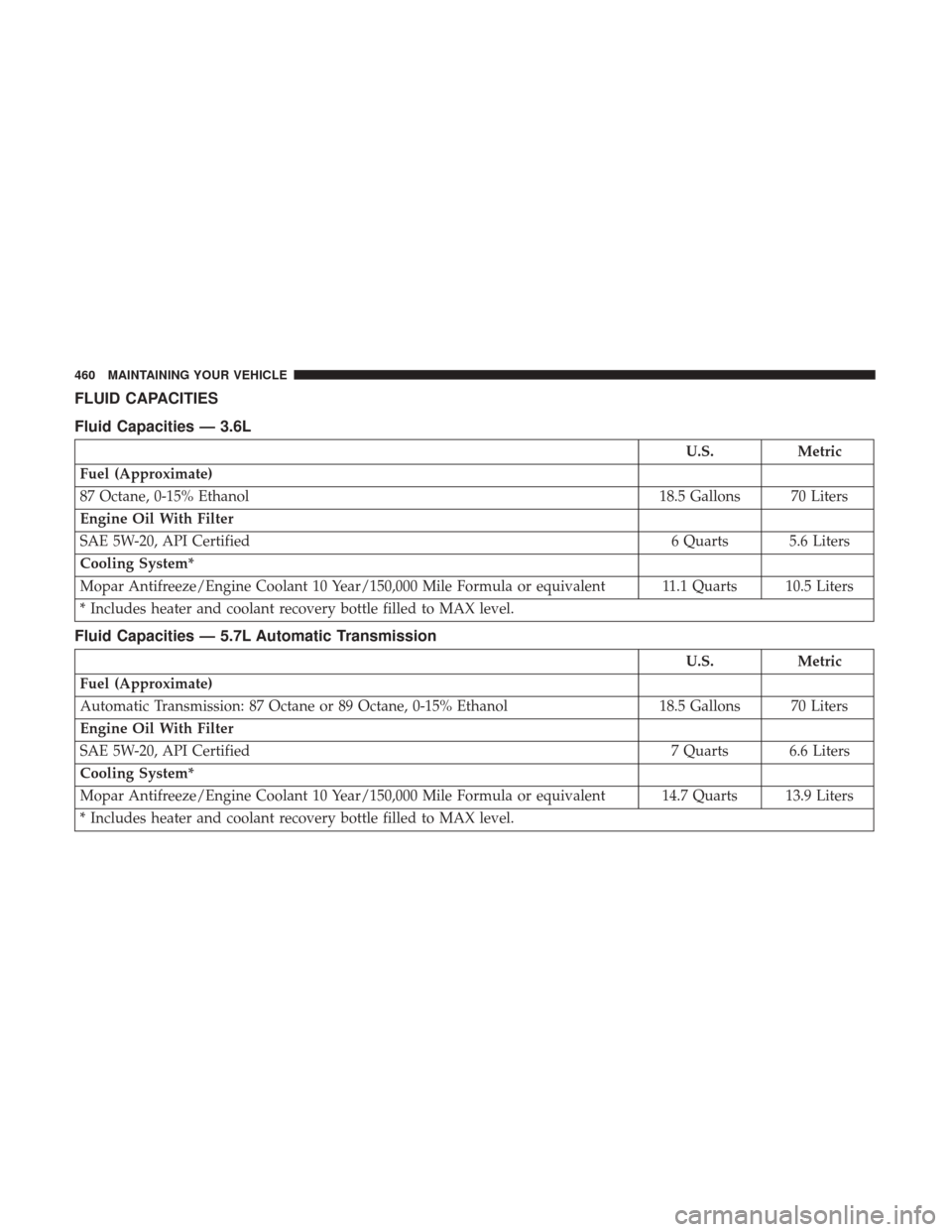
FLUID CAPACITIES
Fluid Capacities — 3.6L
U.S.Metric
Fuel (Approximate)
87 Octane, 0-15% Ethanol 18.5 Gallons 70 Liters
Engine Oil With Filter
SAE 5W-20, API Certified 6 Quarts 5.6 Liters
Cooling System*
Mopar Antifreeze/Engine Coolant 10 Year/150,000 Mile Formula or equivalent 11.1 Quarts 10.5 Liters
* Includes heater and coolant recovery bottle filled to MAX level.
Fluid Capacities — 5.7L Automatic Transmission
U.S. Metric
Fuel (Approximate)
Automatic Transmission: 87 Octane or 89 Octane, 0-15% Ethanol 18.5 Gallons 70 Liters
Engine Oil With Filter
SAE 5W-20, API Certified 7 Quarts 6.6 Liters
Cooling System*
Mopar Antifreeze/Engine Coolant 10 Year/150,000 Mile Formula or equivalent 14.7 Quarts 13.9 Liters
* Includes heater and coolant recovery bottle filled to MAX level.
460 MAINTAINING YOUR VEHICLE
Page 463 of 506
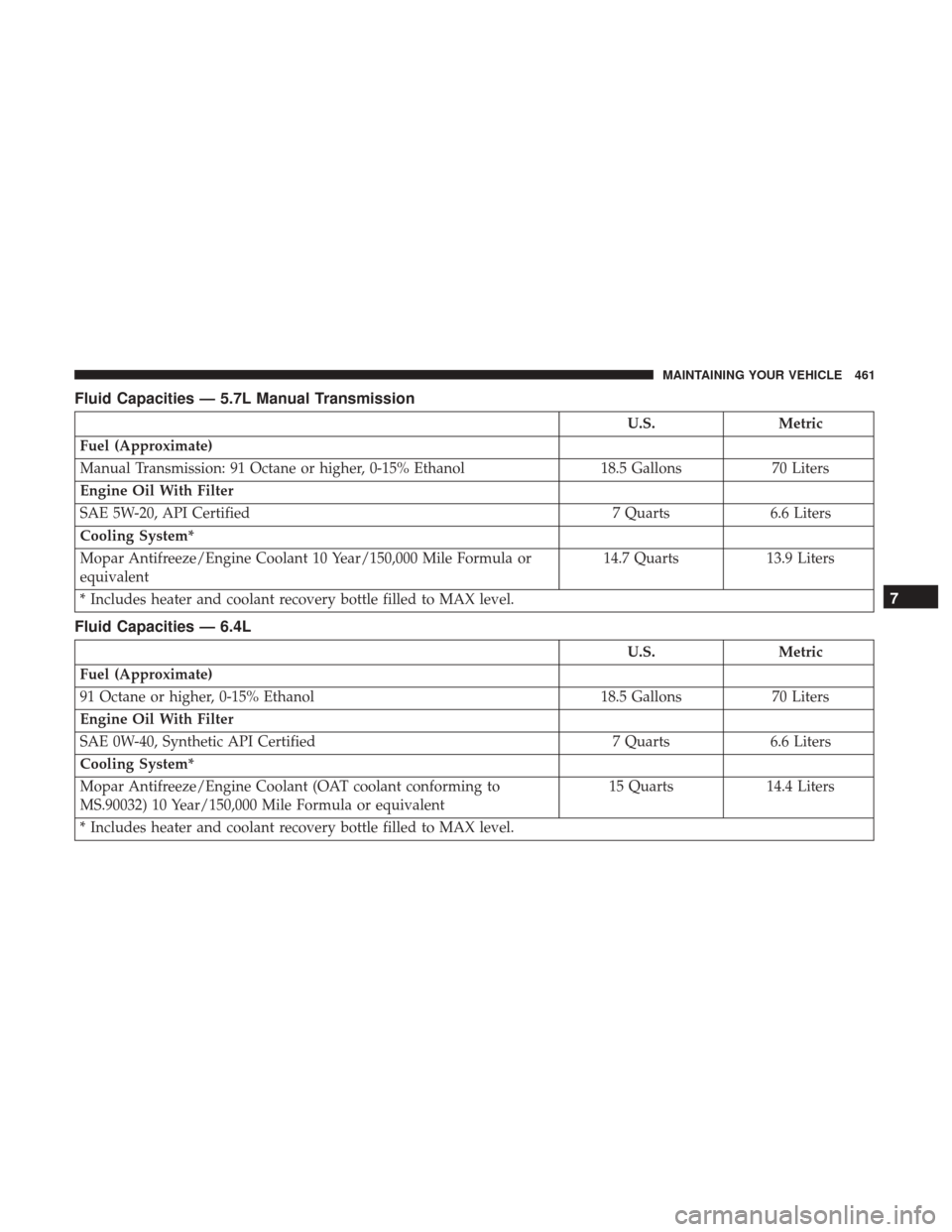
Fluid Capacities — 5.7L Manual Transmission
U.S.Metric
Fuel (Approximate)
Manual Transmission: 91 Octane or higher, 0-15% Ethanol 18.5 Gallons70 Liters
Engine Oil With Filter
SAE 5W-20, API Certified 7 Quarts6.6 Liters
Cooling System*
Mopar Antifreeze/Engine Coolant 10 Year/150,000 Mile Formula or
equivalent 14.7 Quarts
13.9 Liters
* Includes heater and coolant recovery bottle filled to MAX level.
Fluid Capacities — 6.4L
U.S. Metric
Fuel (Approximate)
91 Octane or higher, 0-15% Ethanol 18.5 Gallons70 Liters
Engine Oil With Filter
SAE 0W-40, Synthetic API Certified 7 Quarts6.6 Liters
Cooling System*
Mopar Antifreeze/Engine Coolant (OAT coolant conforming to
MS.90032) 10 Year/150,000 Mile Formula or equivalent 15 Quarts
14.4 Liters
* Includes heater and coolant recovery bottle filled to MAX level.
7
MAINTAINING YOUR VEHICLE 461
Page 470 of 506
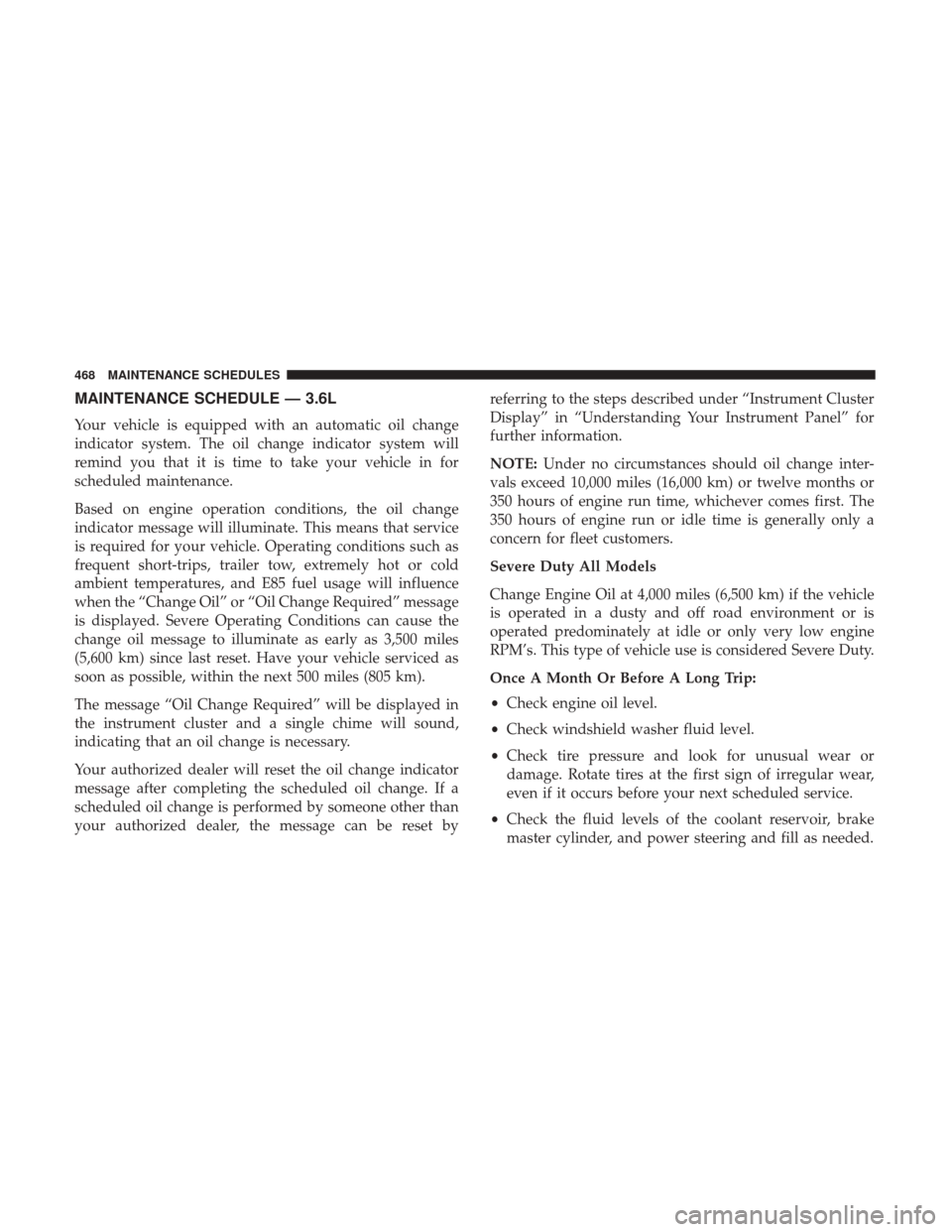
MAINTENANCE SCHEDULE — 3.6L
Your vehicle is equipped with an automatic oil change
indicator system. The oil change indicator system will
remind you that it is time to take your vehicle in for
scheduled maintenance.
Based on engine operation conditions, the oil change
indicator message will illuminate. This means that service
is required for your vehicle. Operating conditions such as
frequent short-trips, trailer tow, extremely hot or cold
ambient temperatures, and E85 fuel usage will influence
when the “Change Oil” or “Oil Change Required” message
is displayed. Severe Operating Conditions can cause the
change oil message to illuminate as early as 3,500 miles
(5,600 km) since last reset. Have your vehicle serviced as
soon as possible, within the next 500 miles (805 km).
The message “Oil Change Required” will be displayed in
the instrument cluster and a single chime will sound,
indicating that an oil change is necessary.
Your authorized dealer will reset the oil change indicator
message after completing the scheduled oil change. If a
scheduled oil change is performed by someone other than
your authorized dealer, the message can be reset byreferring to the steps described under “Instrument Cluster
Display” in “Understanding Your Instrument Panel” for
further information.
NOTE:
Under no circumstances should oil change inter-
vals exceed 10,000 miles (16,000 km) or twelve months or
350 hours of engine run time, whichever comes first. The
350 hours of engine run or idle time is generally only a
concern for fleet customers.
Severe Duty All Models
Change Engine Oil at 4,000 miles (6,500 km) if the vehicle
is operated in a dusty and off road environment or is
operated predominately at idle or only very low engine
RPM’s. This type of vehicle use is considered Severe Duty.
Once A Month Or Before A Long Trip:
• Check engine oil level.
• Check windshield washer fluid level.
• Check tire pressure and look for unusual wear or
damage. Rotate tires at the first sign of irregular wear,
even if it occurs before your next scheduled service.
• Check the fluid levels of the coolant reservoir, brake
master cylinder, and power steering and fill as needed.
468 MAINTENANCE SCHEDULES
Page 472 of 506
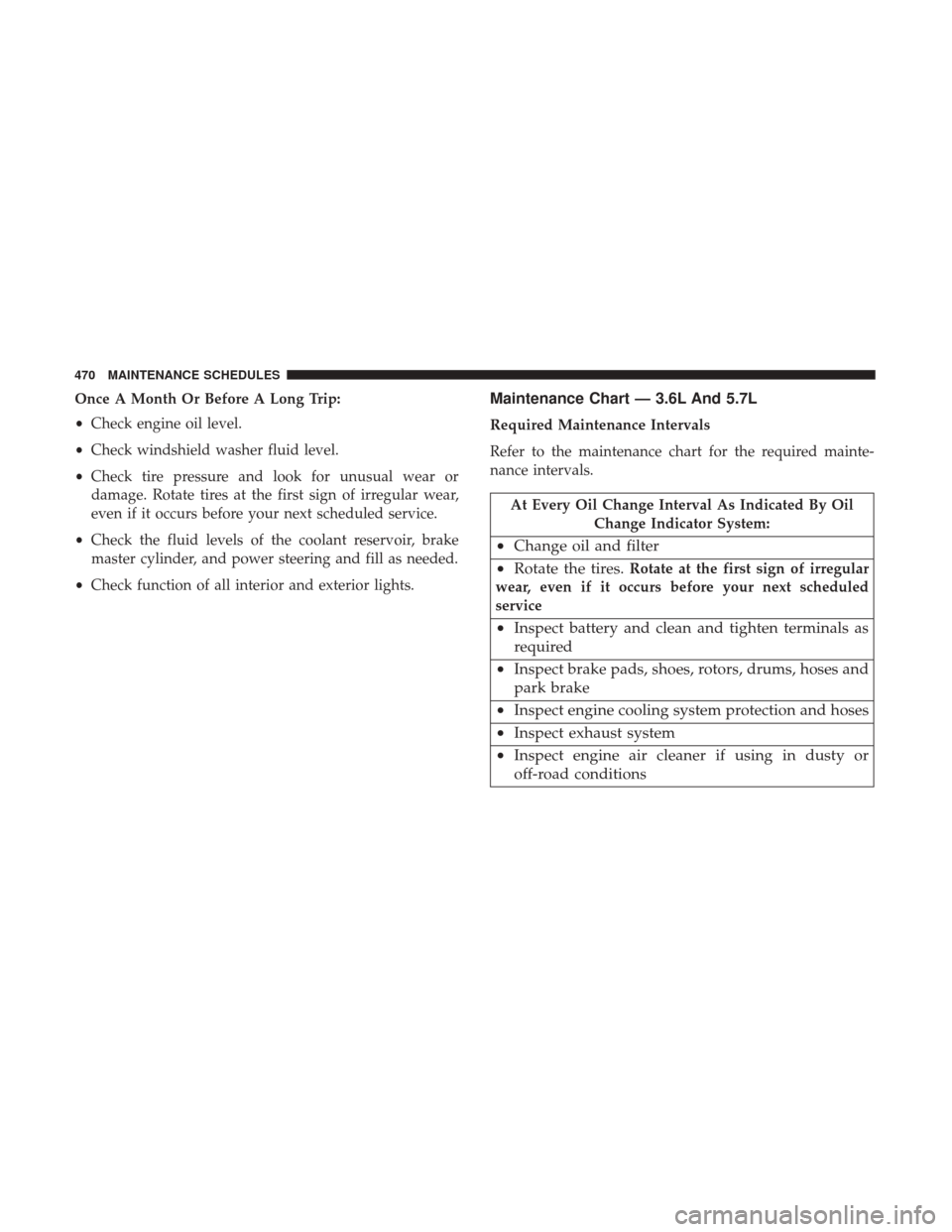
Once A Month Or Before A Long Trip:
•Check engine oil level.
• Check windshield washer fluid level.
• Check tire pressure and look for unusual wear or
damage. Rotate tires at the first sign of irregular wear,
even if it occurs before your next scheduled service.
• Check the fluid levels of the coolant reservoir, brake
master cylinder, and power steering and fill as needed.
• Check function of all interior and exterior lights.Maintenance Chart — 3.6L And 5.7L
Required Maintenance Intervals
Refer to the maintenance chart for the required mainte-
nance intervals.
At Every Oil Change Interval As Indicated By Oil
Change Indicator System:
•Change oil and filter
• Rotate the tires.
Rotate at the first sign of irregular
wear, even if it occurs before your next scheduled
service
• Inspect battery and clean and tighten terminals as
required
• Inspect brake pads, shoes, rotors, drums, hoses and
park brake
• Inspect engine cooling system protection and hoses
• Inspect exhaust system
• Inspect engine air cleaner if using in dusty or
off-road conditions
470 MAINTENANCE SCHEDULES
Page 476 of 506
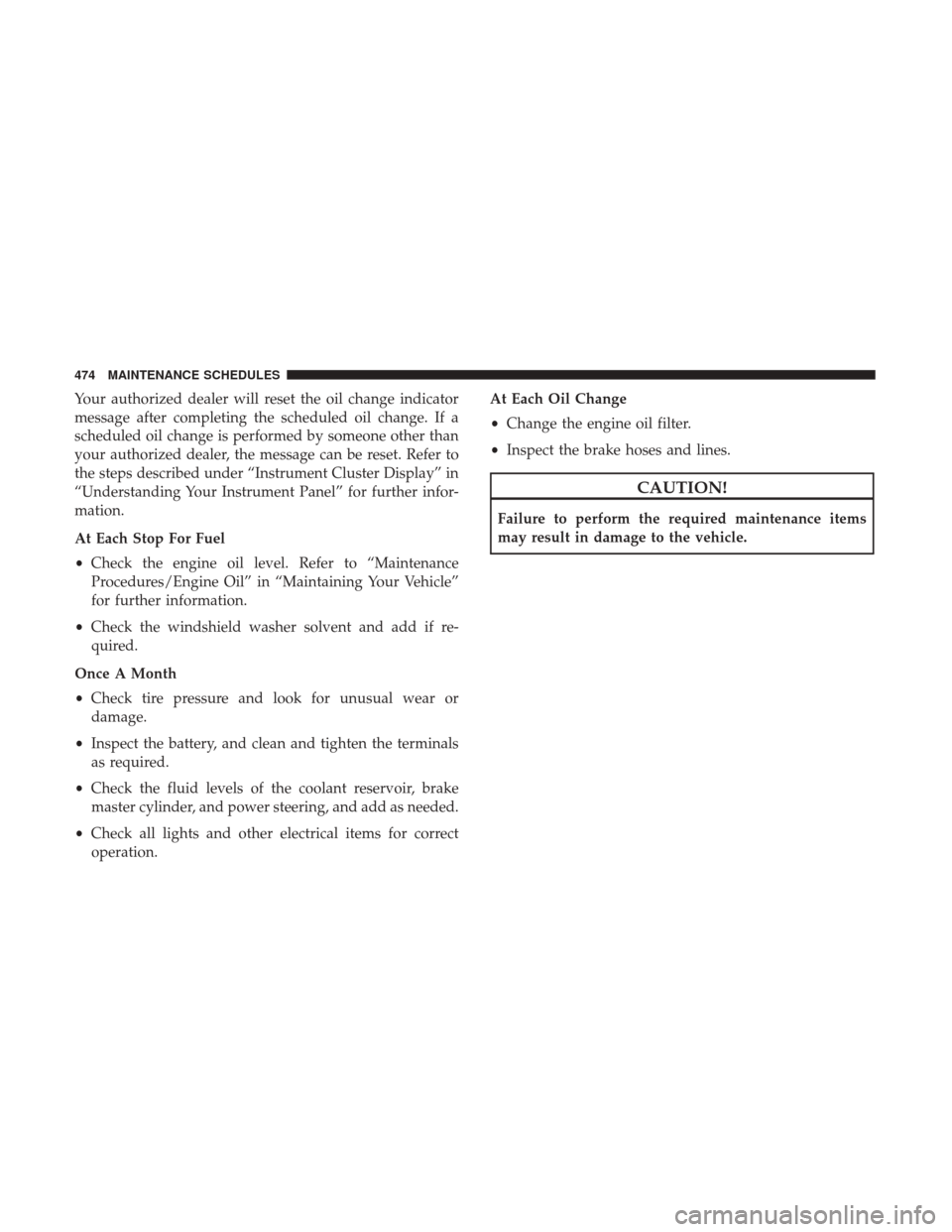
Your authorized dealer will reset the oil change indicator
message after completing the scheduled oil change. If a
scheduled oil change is performed by someone other than
your authorized dealer, the message can be reset. Refer to
the steps described under “Instrument Cluster Display” in
“Understanding Your Instrument Panel” for further infor-
mation.
At Each Stop For Fuel
•Check the engine oil level. Refer to “Maintenance
Procedures/Engine Oil” in “Maintaining Your Vehicle”
for further information.
• Check the windshield washer solvent and add if re-
quired.
Once A Month
• Check tire pressure and look for unusual wear or
damage.
• Inspect the battery, and clean and tighten the terminals
as required.
• Check the fluid levels of the coolant reservoir, brake
master cylinder, and power steering, and add as needed.
• Check all lights and other electrical items for correct
operation. At Each Oil Change
•
Change the engine oil filter.
• Inspect the brake hoses and lines.
CAUTION!
Failure to perform the required maintenance items
may result in damage to the vehicle.
474 MAINTENANCE SCHEDULES
Page 489 of 506
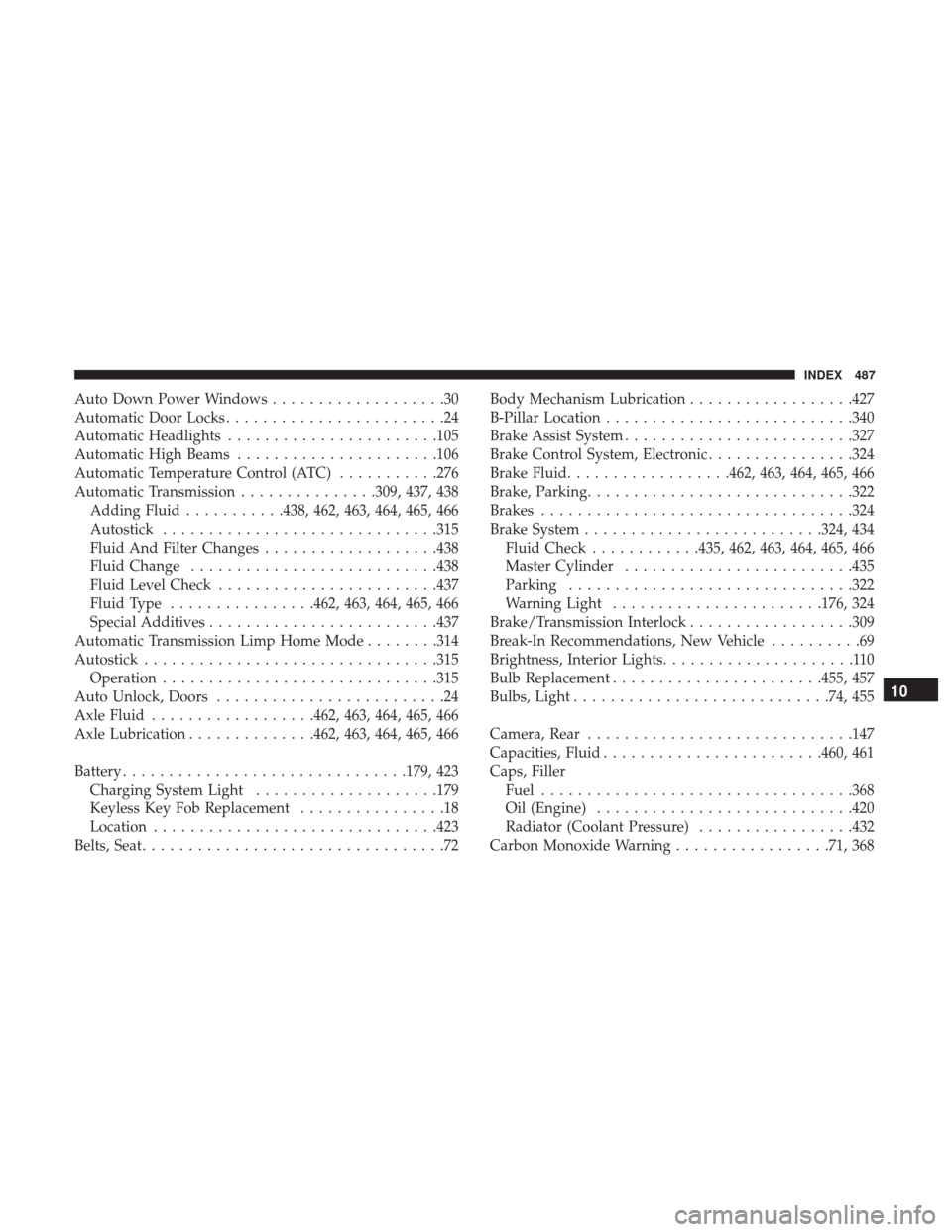
Auto Down Power Windows...................30
Automatic Door Locks ........................24
Automatic Headlights ...................... .105
Automatic High Beams ..................... .106
Automatic Temperature Control (ATC) ...........276
Automatic Transmission ...............309, 437, 438
Adding Fluid ...........438, 462, 463, 464, 465, 466
Autostick ............................. .315
Fluid And Filter Changes ...................438
Fluid Change .......................... .438
Fluid Level Check ....................... .437
Fluid Type ................462, 463, 464, 465, 466
Special Additives ........................ .437
Automatic Transmission Limp Home Mode ........314
Autostick ............................... .315
Operation ............................. .315
Auto Unlock, Doors .........................24
Axle Fluid ..................462, 463, 464, 465, 466
Axle Lubrication ..............462, 463, 464, 465, 466
Battery .............................. .179, 423
Charging System Light ....................179
Keyless Key Fob Replacement ................18
Location .............................. .423
Belts, Seat .................................72 Body Mechanism Lubrication
..................427
B-Pillar Location .......................... .340
Brake Assist System ........................ .327
Brake Control System, Electronic ................324
Brake Fluid ..................462, 463, 464, 465, 466
Brake, Parking ............................ .322
Brakes ................................. .324
Brake System ......................... .324, 434
Fluid Check ............435, 462, 463, 464, 465, 466
Master Cylinder ........................ .435
Parking .............................. .322
Warning Light ...................... .176,
324
Brake/Transmission Interlock ..................309
Break-In Recommendations, New Vehicle ..........69
Brightness, Interior Lights .....................110
Bulb Replacement ...................... .455, 457
Bulbs, Light ........................... .74, 455
Camera, Rear ............................ .147
Capacities, Fluid ....................... .460, 461
Caps, Filler Fuel ................................. .368
Oil (Engine) ........................... .420
Radiator (Coolant Pressure) .................432
Carbon Monoxide Warning .................71, 368
10
INDEX 487
Page 490 of 506

Cargo (Vehicle Loading)..................... .370
Car Washes .............................. .439
Center High Mounted Stop Light ...............459
Certification Label ......................... .370
Chains, Tire ............................. .354
Changing A Flat Tire ....................... .392
Chart, Tire Sizing .......................... .336
Check Engine Light (Malfunction Indicator Light). . . .415
Checking Your Vehicle For Safety ................70
Checks, Safety .............................70
Child Restraint .............................54
Child Restraints Booster Seats ............................57
Child Restraints ..........................54
Child Seat Installation ......................65
How To Stow An Unused ALR Seat Belt .........63
Infants And Child Restraints .................56
Lower Anchors And Tethers For Children ........59
Older Children And Child Restraints ...........56
Seating Positions ..........................58
Clean Air Gasoline ........................ .365
Cleaning Wheels ............................... .440
Climate Control ........................... .268
Cold Weather Operation ..................... .302Compact Spare Tire
........................ .350
Console, Overhead ........................ .149
Contract, Service .......................... .482
Coolant Pressure Cap (Radiator Cap) .............432
Cooling System ........................... .430
Adding Coolant (Antifreeze) .................431
Coolant Capacity .....................460, 461
Coolant Level ....................... .430, 433
Disposal Of Used Coolant ..................433
Drain, Flush, And Refill ....................431
Inspection ............................. .433
Points To Remember ..................... .434
Pressure Cap ........................... .432
Radiator Cap .......................... .432
Selection Of Coolant
(Antifr
eeze)............431, 460, 461, 462, 464, 465
Corrosion Protection ....................... .439
Cruise Control (Speed Control) .................120
Cruise Light ....................194, 195, 197, 198
Cupholders .......................... .163, 444
Customer Assistance ....................... .480
Customer Programmable Features ...........212, 213
Daytime Brightness, Interior Lights ..............111
Daytime Running Lights .....................107
488 INDEX